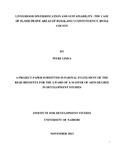| dc.description.abstract | Natural disasters continue to cause deaths, injuries, and economic loses around the world. One such disaster is floods. Flooding in Kenya is experienced perennially and most affected areas are Budalang’i, Nyatike, Kano plains and Lower parts of Tana River. Budalang’i flood plain has experienced floods since 1937 up to 2013.These floods have had effects on the livelihoods of the people in Budalang’i flood plain hence the residents have learnt to survive with the effects by employing several coping strategies. These coping strategies have developed into alternative livelihoods over the years, however, they seem to be unsustainable since there are high rates of absolute poverty and people are always in need of help during floods. This study therefore sought to examine why the livelihoods of households in Budalang’i flood plain remained unsustainable over the years. Specifically, the study sought to address three research objectives: first was to find out the livelihood diversification strategies adopted by households due to the perennial floods; second was to establish the determinants of livelihood diversification strategies employed by the households in Budalang’i and finally to examine the factors influencing the sustainability of the households’ livelihood diversification strategies adopted. The study population comprised of households that were mostly affected by the occurrence of floods and this were mainly in Bunyala Central but some were also in parts of Bunyala West. The study used two methods of data collection which included household survey and key informant interviews. A sample of sixty households were selected for the household survey while eight key informants who included two chiefs of the two locations, four villages elders, an official from government and non-governmental organization in the area. The study findings revealed that the respondents still regard crop farming as their major source of livelihoods despite the perennial floods. The respondents are also involved in fishing, small scale business, casual work on the farms and some are employed in low paying jobs.
Livelihood diversification of the household was determined by several factors. The study revealed that age, level of education, social and financial assets determined the alternative livelihood chosen. On sustainability of livelihoods, the study revealed that small farms owned by the respondents produced low yields which could not take them for long period of time. In addition, expenses such as school fees were said to contribute to faster depletion of income.
Overfishing in Lake Victoria has led to reduction in fish stock and as a result affecting the income of fishermen leading to unsustainable livelihoods in the area. Furthermore, the continued disruption of farms, food store and assets by floods has always resulted to unsustainable livelihoods. The view of alternative livelihoods as fall back activities just for survival also made respondents not to invest much in them leading to low returns and eventually unsustainable livelihoods. The study therefore recommends that the residents of Budalang’i flood plain should be educated on meaningful investment on alternative livelihoods and also be offered grants for the investment so that they can have sustainable livelihoods. | en |

